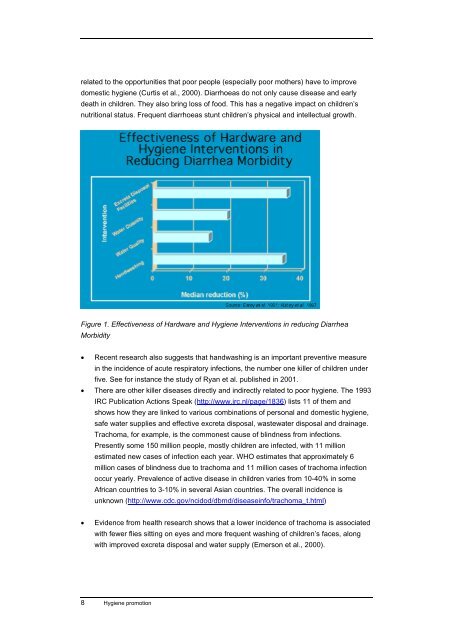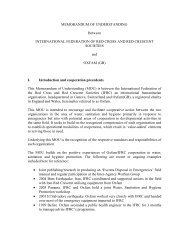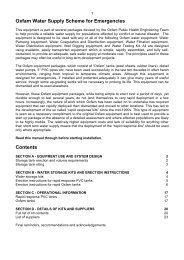Hygiene Promotion - IRC International Water and Sanitation Centre
Hygiene Promotion - IRC International Water and Sanitation Centre
Hygiene Promotion - IRC International Water and Sanitation Centre
You also want an ePaper? Increase the reach of your titles
YUMPU automatically turns print PDFs into web optimized ePapers that Google loves.
elated to the opportunities that poor people (especially poor mothers) have to improvedomestic hygiene (Curtis et al., 2000). Diarrhoeas do not only cause disease <strong>and</strong> earlydeath in children. They also bring loss of food. This has a negative impact on children’snutritional status. Frequent diarrhoeas stunt children’s physical <strong>and</strong> intellectual growth.Figure 1. Effectiveness of Hardware <strong>and</strong> <strong>Hygiene</strong> Interventions in reducing DiarrheaMorbidity• Recent research also suggests that h<strong>and</strong>washing is an important preventive measurein the incidence of acute respiratory infections, the number one killer of children underfive. See for instance the study of Ryan et al. published in 2001.• There are other killer diseases directly <strong>and</strong> indirectly related to poor hygiene. The 1993<strong>IRC</strong> Publication Actions Speak (http://www.irc.nl/page/1836) lists 11 of them <strong>and</strong>shows how they are linked to various combinations of personal <strong>and</strong> domestic hygiene,safe water supplies <strong>and</strong> effective excreta disposal, wastewater disposal <strong>and</strong> drainage.Trachoma, for example, is the commonest cause of blindness from infections.Presently some 150 million people, mostly children are infected, with 11 millionestimated new cases of infection each year. WHO estimates that approximately 6million cases of blindness due to trachoma <strong>and</strong> 11 million cases of trachoma infectionoccur yearly. Prevalence of active disease in children varies from 10-40% in someAfrican countries to 3-10% in several Asian countries. The overall incidence isunknown (http://www.cdc.gov/ncidod/dbmd/diseaseinfo/trachoma_t.html)• Evidence from health research shows that a lower incidence of trachoma is associatedwith fewer flies sitting on eyes <strong>and</strong> more frequent washing of children’s faces, alongwith improved excreta disposal <strong>and</strong> water supply (Emerson et al., 2000).8 <strong>Hygiene</strong> promotion
















